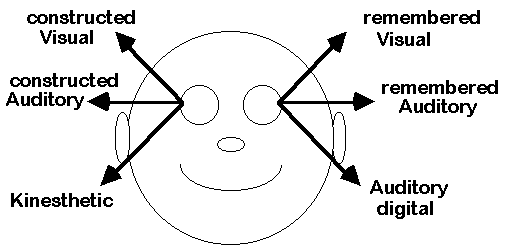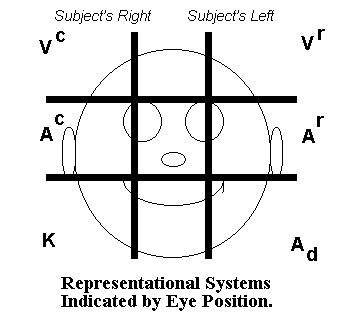The Article of the Month
by Robert Dilts.
Eye Movements and NLP
Eye movements as indicators of specific
cognitive processes is one of the most well known, if controversial,
discoveries of NLP, and potentially one of the most valuable. According to NLP,
automatic, unconscious eye movements, or "eye accessing cues," often
accompany particular thought processes, and indicate the access and use of
particular representational systems.
The notion that eye movements might be
related to internal representations was first suggested by American
psychologist William James in his book Principles of Psychology (1890, pp.
193-195). Observing that some forms of micromovement always accompany thought,
James wrote:
In attending to either an idea or a sensation belonging to a particular sense-sphere, the movement is the adjustment of the sense-organ, felt as it occurs. I cannot think in visual terms, or example, without feeling a fluctuating play of pressures, convergences, divergences, and accommodations in my eyeballs...When I try to remember or reflect, the movements in question. . .feel like a sort of withdrawal from the outer world. As far as I can detect, these feelings are due to an actual rolling outwards and upwards of the eyeballs.
What James is describing is well known in NLP
as a visual eye-accessing cue [eyes moving up and to the left or right for
visualization]. James' observation lay dormant, however, until the early 1970's
when psychologists such as Kinsbourne (1972), Kocel et al (1972) and Galin
& Ornstein (1974), began to equate lateral eye movements to processes
related to the different hemispheres of the brain. They observed that
right-handed people tended to shift their heads and eyes to the right during "left
hemisphere" (logical and verbally oriented) tasks, and to move their heads
and eyes to the left during "right hemisphere" (artistic and
spatially oriented) tasks. That is, people tended to look in the opposite
direction of the part of the brain they were using to complete a cognitive
task.
In early 1976, Richard Bandler, John Grinder
and their students began to explore the relationship between eye movements and
the different senses as well as the different cognitive processes associated
with the brain hemispheres.
In 1977 Robert Dilts conducted a study, at
the Langley Porter Neuropsychiatric Institute in San Francisco, attempting to
correlate eye movements to particular cognitive and neurophysiological
processes. Dilts used electrodes to track both the eye movements and brain wave
characteristics of subjects who were asked questions related to using the
various senses of sight, hearing and feeling for tasks involving both memory
("right brain" processing) and mental construction ("left brain"
processing). Subjects were asked a series of questions in eight groupings. Each
grouping of questions appealed to a particular type of cognitive
processing_visual, auditory, kinesthetic, and emotional (visceral feelings).
Each was also geared to either memory (non-dominant hemisphere processing) or
construction (dominant hemisphere processing). Dilts' recordings tended to
confirm other tests which showed that lateralization of eye movements
accompanied brain activity during different cognitive tasks. This pattern also
seemed to hold for tasks requiring different senses.
As a result of these studies, and many hours
of observations of people from different cultures and racial backgrounds from
all over the world, the following eye movement patterns were identified (Dilts,
1976, 1977; Grinder, DeLozier and Bandler, 1977; Bandler and Grinder, 1979;
Dilts, Grinder, Bandler and DeLozier, 1980):
Eyes Up and
Left: Non-dominant
hemisphere visualization - i.e., remembered imagery (Vr).
Eyes Up and Right: Dominant
hemisphere visualization - i.e., constructed imagery and visual fantasy (Vc).
Eyes Lateral Left: Non-dominant hemisphere auditory processing - i.e., remembered sounds,
words, and "tape loops" (Ar) and tonal discrimination.
Eyes Lateral Right: Dominant
hemisphere auditory processing - i.e., constructed sounds and words (Ac).
Eyes Down and Left: Internal
dialogue, or inner self-talk (Ad).
Eyes Down and Right: Feelings,
both tactile and visceral (K).
Eyes Straight Ahead, but Defocused or Dilated: Quick access of almost any sensory
information; but usually visual.

Basic
NLP Eye Accessing Cues
This pattern appears to be constant for right
handed people throughout the human race (with the possible exception of the
Basques, whose population appears to contain a fair number of 'exceptions to
the rule'). Subsequent studies (Loiselle, 1985 and Buckner, Reese and Reese, 1987)
have supported the NLP claim that eye movements both reflect and influence key
cognitive componants of thought. Many left handed people, however, tend to be
reversed from left to right. That is, their eye accessing cues are the mirror
image of those of the average right hander. They look down and left for
feelings, instead of down and right. Similarly, they look up and to the right
to remember visual imagery, instead of up and to the left, and so on. A small
number of people (including ambidextrous and a few right handed people) will be
reversed in their some of their eye accessing cues (their visual eye movements,
for example), but not the others.
To explore the relationship between eye
movements and thinking for yourself, find a partner, ask the following
questions, and observe his or her eye movements. For each question keep track
of your partner's eye movements in one of the boxes (following the questions
below) by using marks, lines or numbers that represent the sequence of
positions you observe.
- Visual Remembered: Think of the color of your car. What kind of pattern is on your bedspread? Think of the last time you saw someone running. Who were the first five people you saw this morning?
- Visual Construction: Imagine an outline of yourself as you might look from six feet above us and see it turning into a city skyline. Can you imagine the top half of a toy dog on the bottom half of a green hippopotamus?
- Auditory Remembered: Can you think of one of your favorite songs? Think of the sound of clapping. How does your car's engine sound?
- Auditory Constructed: Imagine the sound of a train's whistle changing into the sound of pages turning. Can you hear the sound of a saxophone and the sound of your mother's voice at the same time?
- Auditory Digital (Internal Self Talk): Take a moment and listen to the sound of your own inner voice. How do you know it is your voice? In what types of situations do you talk to yourself the most? Think of the kinds of things that you say to yourself most often.
- Kinesthetic Remembered: (Tactile) When was the last time you felt really wet? Imagine the feelings of snow in your hands. What does a pine cone feel like? When was the last time you touched a hot cooking utensil? (Visceral/Emotional) Can you think of a time you felt satisfied about something you completed? Think of what it feels like to be exhausted. When was the last time you felt impatient?
- Kinesthetic Construction: (Tactile) Imagine the feelings of stickiness turning into the feelings of sand shifting between your fingers. Imagine the feelings of dog's fur turning into the feelings of soft butter. (Visceral/Emotional) Imagine the feelings of frustration turning into the feeling of being really motivated to do something. Imagine the feeling of being bored turning into feeling silly about feeling bored.


It is important to keep in mind, as you are
observing and tracking eye movements, that many people will already have
habitual eye movements, related to their primary representational modality. A
highly visual person may tend to look up and to the left or right, regardless
of which sensory modality is assumed by your question. If you ask such a person
to think of his or her "favorite song," the person may visualize the
cover of the record, tape or CD in order to remember the name of the song. A
kinesthetically oriented person may look down and check his or her feelings to
determine how he or she feels about several songs in order to know which one is
his or her "favorite." Thus it is important to ask people what they
actually did in their minds as they were answering the questions in order to
get an accurate sense of what their eye movements signified.
Once you feel confident in eye movements as
accessing cues, and in your ability to "read" them, there are many
ways they can be used. As was mentioned earlier, habitual eye movements reflect
a person's preferred sensory modality. If you ask someone, "What is
something that is really important to you? Think of it now," the placement
of the person's eyes as he or she is answering your question will probably tell
you a lot about that person's most valued representational system.
Eye movements can also be used to determine
how truthful or congruent a person is being. If a person is describing an event
that he or she has witnessed or participated in, for instance, the person's
eyes should move primarily to his or her left (if the person is right handed),
indicating memory access. If the person looks up and to the right a lot,
however, it is likely that the person is constructing or reconstructing some
aspect of the experience he or she is describing. This may indicate that the
person is either uncertain or being untruthful about what he or she is saying.
The most common application of eye positions in NLP is to determine the representational strategies a person is using in order to think or make a decision. Since many aspects of people's thinking processes are unconscious to them, spontaneous eye movements can be an extremely important part of eliciting and modeling a person's inner strategies for decision making, learning, motivation, memory, etc.
References
Patterns of the Hypnotic Techniques of Milton H.
Erickson, M.D. Vol. II,
Grinder, J., DeLozier, J. and Bandler, R., 1977.
NLP Vol. I,
Dilts, R., et al, Meta Publications, Capitola, CA, 1980.
Roots of NLP, Dilts, R., Meta Publications, Capitola, CA, 1983.
Eye and Head Turning Indicates Cerebral Lateralization; Kinsbourne, M., Science, 179, pp. 539_541, 1972.
Lateral Eye Movement and Cognitive Mode; Kocel, K., et al., Psychon Sci. 27: pp. 223_224, 1972.
Individual Differences in Cognitive Style_Reflective Eye Movements; Galin, D. and Ornstein, R., Neuropsychologia, 12, pp. 376_397, 1974.
The Effect of Eye Placement On Orthographic Memorization; Loiselle, Fran_ois, Ph.D. Thesis, Facult_ des
Sciences Sociales, Universit_ de Moncton, New Brunswick, Canada, 1985.
Eye Movement As An Indicator of Sensory Components in Thought; Buckner, W., Reese, E. and Reese, R., Journal
of Counseling Psychology, 1987, Vol. 34, No 3.
Also see the NLP Pattern of the Month or the Archives if you are interested in checking out NLP in more depth.
You also may want to visit the Anchor Point Page. Anchor Point is the practical journal of NLP.
For information on Robert Dilts’ products and
services, please see Upcoming Seminars or Robert’s Product Page or
return to Home Page. If you have problems or
comments concerning our WWW service, please send e-mail to the following
address: michaelp@bowsprit.com.
This page, and all contents, are Copyright © 1998 by Robert Dilts., Santa Cruz, CA.